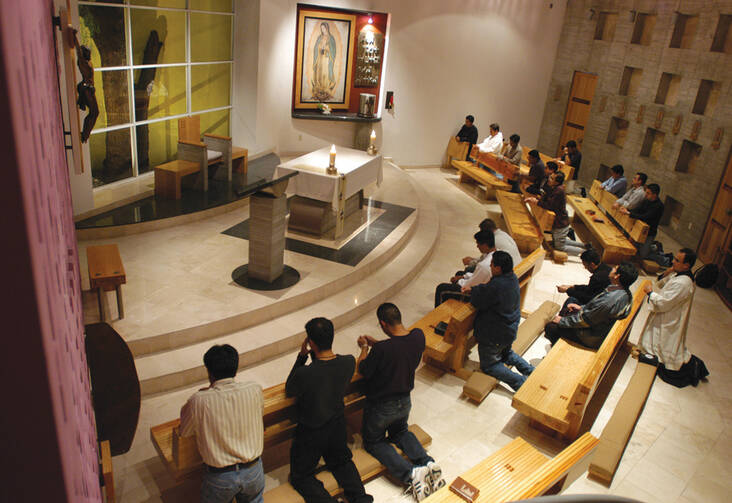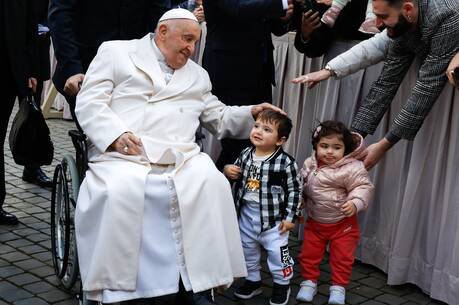When I told my teachers in grade school that I thought I wanted to become a priest, they beamed and did everything possible to encourage me. Their enthusiasm was matched, if not surpassed, by my supportive parents and siblings, my parish priest and even my neighbors. My entire world (as I knew it then) was united in support of my choice of a vocation—even the non-Catholics. And this wasn’t the case only for me. Catholic parents and family members very often found pride in the daughter who chose a life consecrated to Jesus or the son who gave himself to serve the church as a priest. It was an honor for the average Catholic family to have a priest, sister or brother in the family. It was commonplace to find respect for men and women who answered the call to witness Christ in consecrated life; everyone knew that they were among those who helped to make the world a better place to live.
These days there is more skepticism surrounding the prospect of a son or daughter, pupil or friend becoming a priest or religious sister. It sometimes seems that a culture of discouragement has set in, strengthened by scandals in the church. Therefore, one of the tasks of the new evangelization is to build—or better put, rebuild—a culture of vocations in the church. A culture of vocations is one that provides the necessary social supports for each person to hear and respond to the call of God in his or her life. It helps youth and young adults embrace the priesthood or the consecrated life with great enthusiasm and joy.
Much of the emphasis now is rightfully placed on new ways to bring people back into participation in the life and mission of the church. But the new evangelization requires good and effective leadership in the church to achieve its goal—the proclamation of the death and resurrection of Jesus Christ. As we observe National Vocation Awareness Week during the Year of Faith, it would be good to ask ourselves: How do we rebuild a culture of vocations for the new evangelization?
This past September, the Secretariat of Clergy, Consecrated Life and Vocations of the U.S. Conference of Catholic Bishops released the findings of a major survey of Catholic youth and young adults on their consideration of a vocation—a survey that produced some very telling conclusions. The study, titled “Consideration of Priesthood and Religious Life Among Never-Married U.S. Catholics,” was conducted by the Center for Applied Research in the Apostolate and was partially funded by a generous grant from the Conrad N. Hilton Foundation. The survey and analysis by CARA provide helpful information for religious communities, dioceses, parishes, schools and families to encourage a culture of vocations.
A Serious Consideration
The good news from the study is that there is no shortage of interest in religious vocations in the United States. Among all the respondents to the scientific survey, 12 percent of never-married Catholic men age 14 and older had considered priesthood or religious life at least “a little seriously.” Similarly, 10 percent of never-married Catholic women of the same age had considered religious life at least “a little seriously.” In raw numbers, that extrapolates to almost 2.7 million people. More significantly, 3 percent and 2 percent of the respondents (men and women) had “very seriously” considered a religious vocation, the highest possible category respondents could choose. This represents more than 600,000 youth and young adults in the U.S. Catholic population. This is encouraging news, perhaps even surprising, when one considers all of the negative press about the church.
The study was designed to discover key factors for the consideration of a vocation among our Catholic youth and young adult population today. In the survey data four key correlations strongly emerge.
1. Catholic education. Among male respondents, those who attended Catholic secondary school (grades 9-12) were more than six times more likely to have considered becoming a priest or a religious than those who did not attend a Catholic secondary school. For women it was attendance in a Catholic primary school that was important. Female respondents who attended Catholic primary school were more than three times more likely to consider being a religious sister than those who did not.
2. Participation in parish religious education programs, youth and young adult groups. Women who participated in a parish high school youth group were more than nine times more likely to consider a religious vocation. For men, the key age was participation in a parish youth group during their primary school years (grades K-8). Those men who participated were more than five times more likely to consider becoming a priest or religious than those who did not.
3. Encouragement from others. Having even one person encourage an individual to consider a religious vocation doubles the likelihood that they will do so, for both men and women. Furthermore, the effect is additive. If three persons offered encouragement, respondents were more than five times more likely to consider a religious vocation.
4. Knowing someone who is a priest, religious sister or brother or seminarian. Individuals who had a personal connection to someone in religious life were one and a half times more likely to consider this vocation for themselves compared to those who did not have this connection. Here, too, the effect was additive. The more religious one knew, the more consideration was given to the religious life.
What is striking here is that in all four key areas that correlated with a greater likelihood of consideration of a vocation, personal relationships are key. The positive influences for a vocation identified in the survey results seem to be more affective than cognitive. This provides an important fact to remember as we continue to promote a culture of vocations in our church.
Cultivating Cultural Sensitivity
Recent surveys show that Hispanics make up about one third of the Catholic population in the United States and that the proportion of Hispanics will continue to grow in the near future. Already, 48 percent of U.S. Catholics under the age of 31 are Hispanic. These figures tell us that the faith and rich culture of Hispanics are and will continue to be a great blessing for the church in our country. But while the vocation survey shows that Hispanic respondents—both male and female—are no less likely than others to say they have considered a vocation at one time or another, the results also highlight some of the serious challenges the church faces when it comes to fostering the call to religious life among our Hispanic population and giving this group the tools they need to succeed.
Simply put, only 3 percent of all Catholic priests in the United States today are Hispanic, according to the book Same Call, Different Men. This low number mirrors the percentage of Hispanic men and women in religious life, which is also at about 3 percent. While the number of Hispanics in the U.S. church’s recent ordination and profession classes is an improvement, much more still needs to be done. Roughly 15 percent of the newly ordained priests in 2012 were Hispanic, but fewer than 5 percent of these men were U.S. born, even though U.S. born (and English-speaking) Hispanics in this age group far outnumber those who immigrated to the United States. This should serve as a wake-up call. Our young, English-speaking, Hispanic population is very much an untapped, rich source of vocations to the priesthood and consecrated life. If more is not done to encourage vocations among this intensely rich ethnic group that makes up nearly half of our young adult Catholic population, the religious vocation picture in the United States will become increasingly cloudy.
The bishops of our country understand this and have made Hispanic vocations a priority. As we develop strategies in this area, I think it is important to highlight once again the four key areas the CARA study found to be correlated to openness to a vocation in our youth. If we desire to strengthen a culture of vocations within our Hispanic communities, the following are the areas indicated by the vocation survey that are in need of some major strategic development:
Catholic Schools. Only 3 percent of Hispanic children and teens attend Catholic grade schools or high schools. There is need for a concerted effort to increase Hispanic involvement in our Catholic schools. In this effort, I draw attention to the University of Notre Dame’s Task Force on the Participation of Latino Children and Families in Catholic Schools. The task force is working to develop demand, access and the necessary leadership to increase Hispanic enrollment in Catholic schools. More efforts like these are needed.
Participation. Studies show that Hispanics have lower participation rates in religious education and parish youth groups. We have to ask ourselves, “Why is this?” Is it because priests, religious sisters, catechists and other key leaders don’t speak Spanish? Not likely, as the vast majority of our Hispanic youth prefer to speak English with their peers. Language does not seem to be the primary obstacle; rather, it is a lack of familiarity with the various Latino cultures that may inadvertently give the impression to our young Hispanics that they are not welcome or should not expect to feel at home in our “integrated” parishes and schools. How do we better incorporate cultural activities, devotions and symbols into our regular programming for parish and campus youth and young adult ministry?
Encouragement. One of the richest blessings in Hispanic culture is the importance and strength of the home and the extended family. Studies show, however, that there is lower encouragement in Hispanic homes for children to consider a vocation to the priesthood or religious life. How do we encourage families—a clear strength in Hispanic culture—to help in building a culture of vocations?
Knowing someone in religious life. In comparison with other ethnic groups, Hispanic teens show similar or even higher percentages of personal familiarity with a religious sister within or outside the family. Hispanics are less likely, however, to know personally a priest either within or outside the family. Perhaps we need to think more carefully about how to help our non-Hispanic priests to become more familiar, more comfortable and more culturally competent, so that they can be truly present to our Hispanic and Latino youth and young adults.
In Search of Joy
The priority on relationship with Christ in the church has great resonance in the new evangelization for which Pope John Paul II and Pope Benedict XVI have called. The modern world seeks precisely this: to see the faith tangible in genuine Christians. Our deepest poverty, especially in our own country, is not the lack of material means but rather of spiritual riches. Before his election as pope, our Holy Father made this point in an address to catechists and religion teachers. Pope Benedict XVI said that the most profound type of poverty is “the inability of joy, the tediousness of a life considered absurd and contradictory. This poverty is widespread today, in very different forms in the materially rich as well as the poor countries. The inability of joy presupposes and produces the inability to love…. This is why we are need of a new evangelization.”
In many ways, the CARA study on the consideration of a vocation by Catholic youth and young adults shows that the new evangelization is the basic foundation for a healthy culture of vocations in the church. Catechesis and good instruction are essential, but evangelization demands more. It is relational. It asks that we, as a church, focus on inviting people, especially our young people, to respond in love to the God who is love itself. It means that we accept and revel in the good news of Jesus Christ and radiate a Christian joy that is attractive and infectious.








